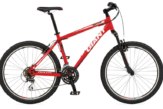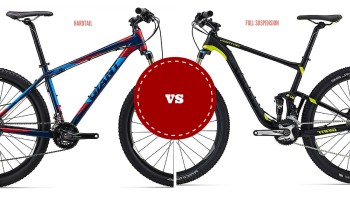When purchasing a new mountain bike the question that typically goes to the top of the list is: Should I get a hardtail or a full-suspension bike and what are the main differences?
Many customers that are new to mountain biking may have the same initial queries and hopefully this article will attempt to answer your questions by showing you the difference between the two bike types and give you some buying tips. In fact, after reading up on hardtail vs full suspension, take a look over here for the best mountain bikes under $300
First, let’s give a run down on what a hardtail mountain bike is – most experienced mountain bikers will already be familiar with the high level differences, so this article will first discuss the real basics and then provide a bit more detail regarding the complexities later. More experienced bikers can skip this initial section and pickup from the latter sections of the article.
Beginners guide to the differences between hardtail mountain bikes and full suspension mountain bikes
Hardtail mountain bikes are bikes that have no suspension in the back. Basically what this means is that there is no shock and there are no pivots, meaning everything is firm. For full suspension bikes there is a shock and pivots which allow the rear wheel to absorb bumps. When you talk about a hardtail you typically refer to a bike that has a suspension fork, whereas a bike with no suspension at all is commonly referred to as a rigid bike, meaning that there is no suspension fork and no rear suspension in the back. Hardtails are typically used for cross country type riding – that is riding that does not involve a lot of big jumps and a lot of drops. There are however dirt jump bikes for tracks that have a lot of jumps but the terrain is relatively smooth – think of a BMX track.
Full suspension bikes cover a much wider variety of riding from cross country to less aggressive trail riding, more aggressive trail riding and even up to freeride type riding and down hills. Hardtails can also move beyond cross-country and go into trail type riding, especially with the bigger wheel sizes. The bigger wheel allow the bumps to be a little bit smoother because the angle of attack over the bumps is a little bit more shallow than a smaller wheel size. Most hardtails will have a fork that is between 80 to 120 millimetres of travel. There are a few anomalies out there by companies that are making all-mountain type hardtails with long travel forks – with forks between 140 to 160 millimetres of travel. Those are more the outliers in the bike world. Most hardtails are again designed for cross country with a shorter travel. Full suspension bikes typically go from 100 millimetres of travel in the front and in the rear all the way out to 8 inches of travel for downhill bike. A trail bike full suspension typically goes between 120 millimetres of travel up to 160mm. Trail bikes probably cover the widest range of riding because they are very versatile bikes and because they can go on really smooth singletrack up to pretty rough, pretty aggressive type riding tracks.
Some people may wonder how a hardtail even works as a mountain bike because you don’t see cars with suspension only in the front nor do you see motorcycles with only suspension in the front. Mountain bikes are designed to cover rough terrain, rocks and roots and that kind of thing – so how is it that hardtail can work? Well, the reason is because the rider on a hardtail is able to shift the weight around to absorb the bumps. When you go over a bump and your front wheel hits the bump your weight is behind the obstacle that you’re hitting, whilst when your back wheel goes over the obstacle your weight is already passed it so the front wheel get pushed over a bump and the rear wheel gets pulled over a bump. That allows the rear wheel to bounce up a little bit better and give you a bit more control then if the front wheel hit an obstacle with no suspension.
And just as a side note – that’s the reason why controlling a front wheel is so important when riding a mountain bike. Your rear wheel can slide around little bit and you’re going to be fine, however if your front wheel slides then you have a more likely chance of falling. Controlling a front wheel is very important and typically what happens to the front wheel will happen to you. Typically if the front wheel really gets hung up on a bump there’s a much better chance of falling and again with the rear wheel, if it hangs up a little bit you can usually get away with it because again you weight is already passed the obstacle and you are pulling the rear wheel over. So riding a hardtail you’re going to have to get out of the saddle more this leads more to the fatiguing factor of a hardtail vs full suspension. You have to use a little bit more body English and be a little bit more attentive on a hardtail then you would be an full suspension mountain bike and that is why often times we recommend a hardtail to new riders because a hardtail teches you and forces you be a better rider. You can get away with my stuff and get a little bit lazy on a full suspension whereas a hardtail forces you to develop mountain biking skills.
Let’s get to the benefits of a hardtail – typically they are going to be at a lower price point than a full suspension mountain bike. That is because you don’t have the shock and a moving pivot so there’s less hardware. Most hardtails are going to be about $700 less than an equally specced full suspension bike. This price difference varies markedly in the lower budget type bikes, but this is a rule of thumb for the more expensive mountain bikes. For advanced riders, with most mainstream mountain bike companies, you’re going to need to spend about $2,000 to get a decent full suspension bike. If your budget is below $2000 you really need to go with the hardtails so that you can get something that’s durable and that’s relatively light and that’s going to be a real mountain bike made by a real mountain biking company. There are, of course, numerous exceptions to this rule, and we have reviewed a number of mountain bikes under 1000 dollars that would be suitable for recreational riders. For more advanced riders, the lowest amount of money that you can really spend on a hardtail is about $500 to get a real mountain bike. Another benefit to hardtail is going to be lower maintenance – you don’t have the pivots that need to be serviced or the shock. The shock on full suspension bikes is going to need some routine maintenance. It is really not that difficult, but for about every 30 to 40 hours of riding you have to take the shock off a bike, remove the sleeve and clean everything up. It should take about 20 minutes or so if you are experienced, and possibly around 30-40 minutes or so if you are doing it for the first time.
With the hardtail you don’t really have to worry about the maintenance aspect, and that is significant if you ride in really muddy or really nasty type conditions. Pivots have become so much better but you can still get dirt inside them. You can probably go 6 months to a year without having to take the pivots off. If you ride frequently you can go at least a year and more between actually having to clean the bearings but that is something that you will have to consider when getting a full suspension bike. Another benefit to a hardtail is that it will be lower weight than a full suspension mountain bike having the same frame material and the same components. On average, a hardtail mountain bike is going to be about 2 pounds lighter than the equivalent full suspension bike. That weight saving is going to vary as far as how much it benefits you depending on what type of riding that you do. On climbs, you’re going to be able to climb faster most likely on a full suspension, whereas if the terrain is really rough and traction is important than a lot of times a full suspension mountain bike is going to be faster in a climb. The reason a lot of racers use a hardtail bike is because it is about 2 pounds lighter than a full suspension mountain bike. Another benefit is going to be that it has a firm pedaling platform and what that means is that the rear end is pretty stiff when you crank on the pedals and it’s not going to bob like a full suspension bike would. When a full suspension bike bobs it means that the suspension actually compresses down and absorbs some of your energy. Nowadays, a lot of modern full suspension mountain bikes do a really good job of not absorbing your peddling energy, but on a hardtail, 100% of your pedaling energy goes into the drivetrain and accelerates the bike forward and that’s really good again for climbing but also for sprinting.
Cornering is also said to better using a hardtail bike. Hardtail mountain bikes kind of spring in and out of corners because the suspension is not there to compress. A final benefit to mention is that a hardtail is a better work-out, so if you are riding for fitness and you want to get some really good upper body strength, you need to work more in a hardtail as you are in-and-out of the saddle a lot more and you have to use your body more and that does strengthen your upper body and back a little bit more than a full suspension bike.

-
Usually less expensive
-
Lower maintenance
-
Lower weight
-
Better cornering

-
Usually more expensive
-
More maintenance
-
Generally 2 pounds heavier
-
Better suspension
Now lets focus on the benefits of a full suspension bike. Full suspension bikes are going to be more comfortable and less fatiguing then a hardtail. The hardtail requires you to get out of the saddle over bumps because you’re using your legs to absorb bumps on a hardtail so every time you get out of the saddle you’re raising your weight up and using your legs to get your weight up. You’re also using your legs to absorb the bumps so over a long ride a hardtail can be very fatiguing compared to a full suspension and even on larger bumps when you’re out of the saddle on a full suspension bike, the bike is just absorbing the hits more than a hardtail so less of the shock of the bump you’re going over carries into your body. Again even when you’re out of the saddle on the full suspension you’re going to be faster on a descent on a full suspension. Part of that is because the control that you get whilst another part is because of the braking performance. What happens on a full suspension when you apply the brakes the tire stays glued to the trail a lot better because on a hardtail when you hit a bump, especially when you’re going fast, the rear tire is going to skip up and its going to bounce up off the trail and that’s going to momentarily cause the tire to not connect with the trail and you’re going to lose braking performance. You get more control and better breaking on a full suspension bike and not only on descending but on really rough terrain, even when it’s flatter, a lot of time you’re going to be faster on a full suspension. So you’re going to have more control in rough terrain on a full suspension bike.
You also get good traction when cornering on a full suspension bike because the tire is able to really stay glued to the trail and not skip up like a hardtail.
Type of Ride
Now lets take a look at the type of riding that a hardtail and a full suspension is better at. Firstly for racing, when racing in the mountains a lot of the time the hardtail is going to be the better choice because you can make up more time on a climb then you could on a descent so if the track is not very rough, where you don’t need the extra traction that a full suspension bike would give you on climbs, you can typically get up faster. Firstly because the weight is lower and secondly because of the really firm pedalling platform.
Trail riding is the term used to cover most of the type of riding that mountain bikers perform. Trail riding covers a wide variety of conditions from rolling terrain and rough terrain, it could be flat or it could have lots of climbs and descents. For this reason, trail bikes are the type of bike that most people are going to ride. Trail bikes range from 120 to 160mm of travel. For most trail type applications, the full suspension bike is going to be the way to go because of the myriad variety. You may not know what type of terrain you are going to encounter on a ride or you may want a bike that just does everything from rough trails with long descents to just your local trails that maybe more rolling and flatter. As mentioned previously, trail bikes are generally full suspension bikes, but that doesn’t mean a hardtail can’t make a good trail bike. It’s going to take a little bit more work and it may be more fatiguing as you may need to work a bit harder.
Previously we mentioned fatigue as a factor when choosing your bike – and this is particularly relevant if you have back problems, you are probably are going to want to go with a full suspension bike. A lot of that shock that would be going to your spine gets absorbed by the bike.
The final verdict
So lets conclude by giving some mountain bike buying advice. We have mentioned a number of pros and cos and things to consider when choosing between a full suspension vs a hardtail bike. 2 of the most important factors when buying a bike is your budget and the type of riding you are going to do. For experienced bikers, if your budget is less than $2,000 or unless you are buying a used mountain bike, you’re probably going to want to get a hardtail. The type of terrain that you ride in is very important to consider also when you’re buying a bike so if you ride in really rough terrain with lots of rocks and roots and that kind of thing, you’re going to be somewhat limited on a hardtail. It does not mean you you won’t be able to do that type of terrain, but you’re going to be somewhat limited in how fast you can ride and how much control you’re going to have. If you’re buying a bike that’s going to be a commuter type bike, or a dirt road or gravel road bike, then most likely you’re going to want to get a hardtail. Hardtails are a lot better on roads and dirt roads generally than a full suspension bike.
The last aspect to consider is wheel size because that does come into play depending on what type of bike you’re going to choose. Most of the time for hardtails we recommend a 29er. The only reason you would not consider a 29er hardtail is because maybe you’re really short or you ride on super tight trails. Saying that, 29ers have pretty short chain stays – the shorter the chain stay, the better the bike is going to handle. The problem with 29er full suspension bikes is that the chainstay gets longer and the bike is harder to manage. Whereas with the hardtail 29er mountain bike manufacturers are able to get the chain stay still pretty short which makes the bike handle very well even with the big wheels.
So to reiterate, if you’re choosing a hardtail, the general recommendation is that you go with the 29er.
Now for full suspension bikes, it is really going to depend on the type of riding that you do. For cross-country bikes, generally a 27.5 is going to be good if you ride tight trails with lots of turns and that kind of thing. If your trails are more wide open than a 29er is going to be the way to go. Try and get a tet rider and if you can test ride both wheel sizes, that’s going to be the way to go because it’s really a matter of a preference.
Now for trail bikes, the 27.5 is the best wheel size. Most of the bikes coming out today in the trail bike category are 27.5, and that’s because the chain stay can get really long. So wheel size does come into play when you choosing between a hardtail and a full suspension bike.
So in conclusion, if you’re trying to decide which bike to get, there are a LOT of factors to consider and hopefully some of the above points will steer you in the right direction.












